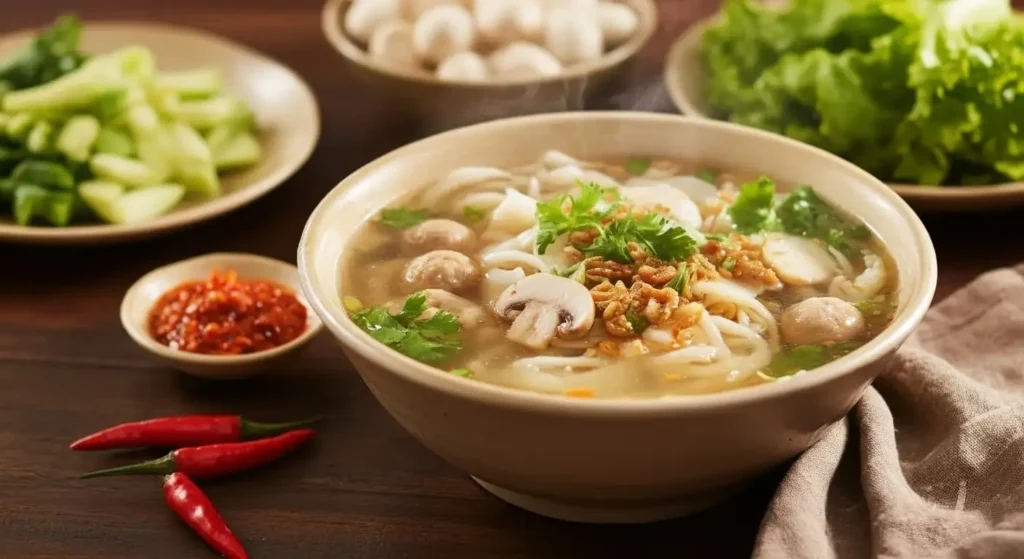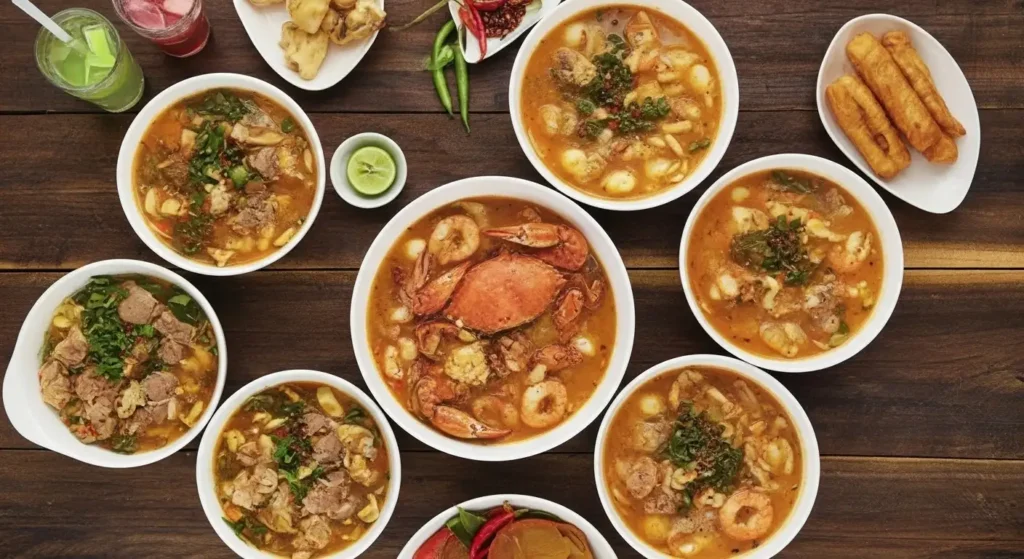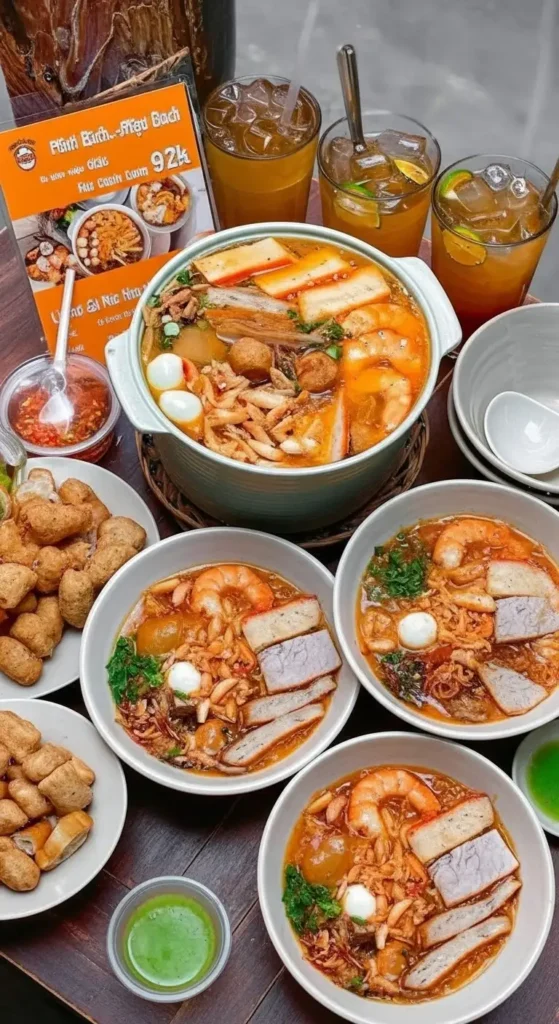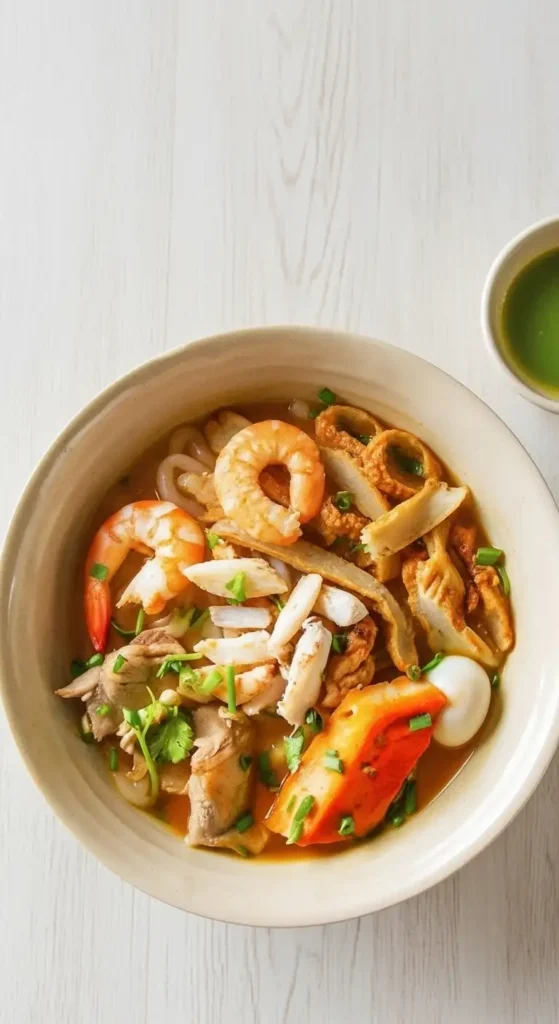Bánh Canh (pronounced “Bahn Kahn”) is a hearty and distinct Vietnamese noodle soup. Often compared to Japanese Udon due to its thick, chewy noodles, Bánh Canh offers a profoundly satisfying texture and a broth that is often richer and thicker than its more famous counterpart, Phở. It’s a true comfort food, with numerous regional variations that showcase the diversity of Vietnamese cuisine.

Bánh Canh: The Basics
The Noodle (Bánh): The defining feature of this dish is its thick, short, and round noodles. Unlike the flat rice noodles of Phở or the vermicelli of Bún, Bánh Canh noodles are traditionally made from tapioca flour (bột lọc), or a blend of tapioca and rice flour (bột gạo). This blend gives the noodles a unique chewy (gummy) and slippery texture, often slightly translucent when cooked.
The Broth (Canh): The soup base is typically a flavorful, savory broth made from simmering pork bones for hours. What sets Bánh Canh apart is that the cooking starch from the noodles and sometimes added tapioca slurry naturally thickens the broth, giving it a rich, almost gravy-like consistency.
Protein & Toppings: Toppings vary widely but often include pork knuckle (giò heo), fish balls (chả cá), sliced pork belly, and in the popular seafood versions, fresh crab meat (cua) and shrimp (tôm).
Serving Style: It is always served hot as a soup.
Variations of Bánh Canh
The versatility of Bánh Canh allows for many regional and ingredient-focused specialties:
| Vietnamese Name | Key Ingredients/Features | Regional Focus |
|---|---|---|
| Bánh Canh Cua | The most famous variety. Features a thick, red-orange, velvety broth (colored with annatto seeds) enriched with fresh crab meat, shrimp, and often crab paste/sausage. | Southern Vietnam (Saigon/HCMC) |
| Bánh Canh Giò Heo | Focuses on a clear, savory pork bone broth topped with a large, tender pork knuckle (giò heo) and sometimes blood pudding. | Popular across Southern and Central regions |
| Bánh Canh Cá Lóc | Features snakehead fish (a freshwater fish), often pan-fried or steamed, in a clear broth. | Central Vietnam (especially Hue) |
| Bánh Canh Nam Phổ | A unique version from Hue with a two-layer look: a thick, savory red layer and a thinner, clear layer on top. Toppings include shrimp and crab patties. | Central Vietnam (Hue) |
| Bánh Canh Trảng Bàng | Known for its clear, clean-tasting broth and simple, quality pork-based toppings, originating from the Tây Ninh province. | Southern Vietnam |
| Bánh Canh with Coconut Milk | A regional twist where the broth is enriched with coconut milk for a richer, creamier, and slightly sweeter flavor. | Mekong Delta Provinces |

How to Eat Bánh Canh
Eating Bánh Canh is a textural experience thanks to the thick noodles and rich broth.
Savor the Broth First: Due to its unique thickness, you often need to use a spoon to fully appreciate the broth’s richness and flavor, which is why many locals refer to it as a “spoon soup.”
Chopstick and Spoon: Use your chopsticks to pick up the slippery, chewy noodles, and the spoon to scoop up the broth and toppings simultaneously.
Customize with Condiments: Bánh Canh is traditionally served with:
Lime Wedges: Essential for adding a necessary tartness to cut through the broth’s richness.
Chili Sauce/Oil: For a spicy kick.
Fish Sauce (Nước Mắm): A touch of nước mắm can boost the savory and umami profile.
Add Herbs: Mix in any accompanying fresh herbs and vegetables (often green onions, cilantro, and sometimes bean sprouts) to add a fragrant, fresh crunch to every bite.
Regional Differences
While Bánh Canh is enjoyed across Vietnam, its preparation and local specialties reflect the distinct culinary styles of the three regions:
| Region | Flavor Profile and Key Dishes | Typical Bánh Canh Style |
|---|---|---|
| Northern Vietnam | Focus on pure, balanced flavors; minimal use of sugar or oil. Not a staple dish; Phở is dominant. | Rarely found; if served, it is often a simple, light pork-based broth. |
| Central Vietnam (Hue, Da Nang) | Known for being spicy and complex; cuisine often features more vibrant colors and smaller portions. | Specializes in fish-based versions like Bánh Canh Cá Lóc and unique local styles like Bánh Canh Nam Phổ. The broth is often less thick than the Southern Cua version. |
| Southern Vietnam (HCMC, Mekong Delta) | Prefers sweeter, richer, and more coconut milk/seafood-influenced flavors. Cuisine embraces diverse toppings. | The home of Bánh Canh Cua (Crab) and Bánh Canh Giò Heo (Pork Knuckle). Broths are typically the thickest and most unctuous, sometimes incorporating coconut milk in the Mekong Delta. |




